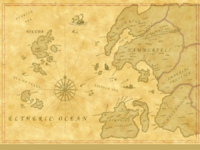The Yokudan Empire was ruled by the ancient Yokudans, the ancestors of the Redguards. The Yokudans had existed on Yokuda since the Merethic Era and during this time warred with the Lefthand Empire for a thousand years. The Yokudans eventually defeated the Lefthanded Elves and prospered in their own right, culminating in the establishment of their own empire.[1][2][3] The ruling body of the Yokudan people was known as the Na-Totambu, a council of kings who represented the various nations of Yokuda.[4][5]
By the First Era, Yokuda had become a vast empire, and developed a tradition of being ruled by a single emperor, however this was eventually abolished in 1E 376. Although each successive emperor remained as the figurehead of the empire, his powers were very much reduced. As a result, the nation descended into three hundred years of continuous civil war between the provincial lords, warrior monks, and brigands, all fighting each other for land and power.[1] In 1E 609, Mansel Sesnit became the Elden Yokeda, or military dictator and waged many of the battles of unification and succeeded in gaining control of almost the entire empire until he was assassinated in 1E 617. His successor, Randic Torn, took over and continued the work of Sesnit, however by the time of his death in 1E 737 internal disturbances still had not been completely eliminated. After his death, another vicious civil war broke out.[1]
In the chaotic aftermath, the "Last Emperor" of Yokuda, Hira, rose to power and attempted to wrestle control of the empire from the people by exterminating the sword-singers. This conflict became known as the War of the Singers. In 1E 780, it came to a climax at the foot of Hattu Mountain, where Frandar Hunding's army of singers crushed the emperor's forces.[6][1]
While the Yokudan Empire in its original form fell after Yokuda sank into the ocean around 1E 792, the Na-Totambu ruling class who migrated to Hammerfell attempted to reproduce the culture and rule of Yokuda as close as possible, with mixed results. This meant that while the empire itself was gone, the Yokudans (and later the Redguards) continued the tradition of monarchic rule in some capacity.[7] One notable example was a Yokudan noble named Tarish-Zi who proclaimed himself emperor and led his warrior band to Craglorn in order to establish his own empire.[8] While he ruled in the ancient Yokudan way, eventually his empire faded into obscurity in the years that followed.[9] Another example was a Yokudan noble named Prince Hubalajad who colonized Hew's Bane and established Abah's Landing, where his descendants would rule for several generations before fading away.[10][11] Another example of parts of Hammerfell being ruled under a monarchy was the rise of Queen Afsar of Alik'r. According to legend, the ruling king died in the late First Era with no heir, which led to squabbling between the Na-Totambu over succession to the throne. Afsar was said to have seized the throne the ancient way by killing the opposition and solidifying her rule. Despite its bloody start, her reign was supposedly very peaceful.[12]
The last known monarch of Hammerfell during the First Era was High King Ar-Azal of the Phyllocid Dynasty, who was best remembered for healing the rift between the Na-Totambu ruling class and the warriors of the Ra Gada by marrying the daughters of their greatest Grandees.[13] When Hammerfell fell to Reman I and was absorbed into the Second Empire, the role of High King was seemingly abolished. Instead, the Na-Totambu and Ra Gada (now known as Crowns and the Forebears respectively) would go on to aid Cyrodiil's administration of Hammerfell. The Crowns retained the rights of noble council and the Forebears were granted rights of ownership within their tribal districts.[14] This, however, did not last, and the Kingdom of Hammerfell that emerged during the Interregnum almost seven hundred years later could be considered the successor to the Yokudan Empire, given the Na-Totambu ruling class took power and reverted back to a hereditary monarchy.[15]
Known RulersEdit
- Emperor Ardanan Haba (centuries prior to 1E 660)[16]
- Elden Yokeda Mansel Sesnit (1E 609 - 1E 617)[1]
- Elden Yokeda Randic Torn (1E 617 - 1E 737)[1]
- Emperor Hira (c. 1E 780)[1]
GalleryEdit
ReferencesEdit
- ^ a b c d e f g Redguards, History and Heroes — Destri Melarg
- ^ Varieties of Faith... — Brother Mikhael Karkuxor of the Imperial College
- ^ Nilata Ruins loading screen in ESO
- ^ The Na-Totambu of Yokuda
- ^ Yokudan King's dialogue in ESO
- ^ Divad the Singer — Destri Melarg
- ^ Lost City of the Na-Totambu loading screen in ESO
- ^ Warlords of the Ra Gada
- ^ Titus Valerius' dialogue in ESO
- ^ In Defense of Prince Hubalajad — Lady Cinnabar of Taneth
- ^ ESO loading screens
- ^ Ramati at-Gar's dialogue in ESO
- ^ The Worthy Ar-Azal, His Deeds
- ^ The Improved Emperor's Guide to Tamriel: Hammerfell — Flaccus Terentius, 2E 581
- ^ Pocket Guide to the Empire, 1st Edition: Hammerfell — Imperial Geographical Society, 2E 864
- ^ Systres History: Volume 2 — Trilam Heladren, Associate Dean of Eltheric History, University of Gwylim
